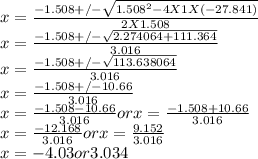
Physics, 25.06.2021 20:40, lucarignot
Lauren pushed a crate of mass 28.9 kg a distance of 2.7 meters along a horizontal surface. On that part of the surface, the crate could slide with negligible friction. Lauren exerted a constant force of 121 newtons for 2.7 meters. The crate then slid down an inclined plane of height 1.8 meters, also with negligible friction. As the crate slid down the plane, the only significant forces on it were the normal force from the plane and gravity (with g = 9.81 meters per second squared). At the bottom of the incline, the crate began sliding along a horizontal surface with ordinary kinetic friction. The coefficient of friction between this surface and the crate was 0.41. This surface ended at a vertical wall after a distance of d2 = 5.2 meters but the crate did not slide that far. Attached to the vertical wall was a long ideal spring with length dy = 3.4 meters and a spring constant of 154 newtons per meter.
Required:
Calculate the distance that the crate compressed the spring before coming to rest.

Answers: 2
Other questions on the subject: Physics

Physics, 21.06.2019 18:10, zuleromanos
An insurance company wants to know if the average speed at which men drive cars is higher than that of women drivers. the company took a random sample of 27 cars driven by men on a highway and found the mean speed to be 72 miles per hour with a standard deviation of 2.2 miles per hour. another sample of 18 cars driven by women on the same highway gave a mean speed of 68 miles per hour with a standard deviation of 2.5 miles per hour. assume that the speeds at which all men and all women drive cars on this highway are both approximately normally distributed with unknown and unequal population standard deviations.
Answers: 2

Physics, 22.06.2019 04:30, elizabethseoane1829
You are traveling in a car going at a constant speed of 100km/h down a long, straight highway. you pass another car going in the same direction which is traveling at a constant speed of 80km/h. as measured from your car's reference frame this other car is traveling at −20km/h. what is the acceleration of your car as measured from the other car's reference frame? what is the acceleration of the other car as measured from your car's reference frame?
Answers: 2

Do you know the correct answer?
Lauren pushed a crate of mass 28.9 kg a distance of 2.7 meters along a horizontal surface. On that p...
Questions in other subjects:

Biology, 23.04.2020 03:42



Mathematics, 23.04.2020 03:42


Spanish, 23.04.2020 03:42



History, 23.04.2020 03:42








